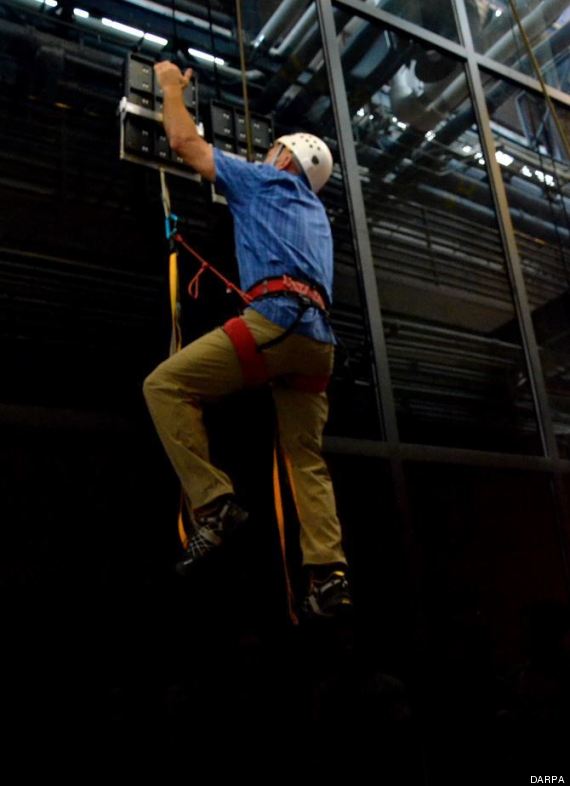
There’s a government division whose only job is to research and develop new technology that helps revolutionize the U.S. military. It’s called the Defense Advanced Research Projects Agency (DARPA), and while most of its scientific breakthroughs relate directly to warfare, DARPA scientists had a hand in creating major innovations that ended up improving everyone’s lives for the better: modern computing, GPS technology and voice-recognition capability (hello, Siri!).
In honor of Veteran’s Day, we’ve rounded up the coolest health-related DARPA projects of 2014 that (hopefully) have exciting applications for civilians, too.
1. This soft, lightweight exosuit mimics the actions of leg muscles and tendons.
Soldiers need to jump, squat, run and march while carrying very big packs on their back. This lightweight exosuit, which is like a wetsuit worn under a normal pair of pants, can help soldiers avoid injury by strengthening their ability to carry heavy loads. But the exosuit has more potential uses beyond warfare. In the video below, Conor Walsh, Ph.D. of Harvard’s Wyss Institute, describes how the suit could one day be used to help people with disabilities walk more smoothly and easily.
“With these systems, our goal is to apply small amounts of assistance to positively impact the mobility of both healthy people and people with physical disabilities,” said Walsh.
“We’re really excited about its potential for the elderly or the military or first responders, for people performing athletic activities,” Walsh continued. “The potential is really just enormous.”
Soft Robotic Exosuit from Wyss Institute on Vimeo.
2. Think of these as prosthetics for your brain.
These wireless, implantable devices, called “neuroprosthetics," will be able to help people overcome memory loss as a result of traumatic brain injury or disease. They work by helping “bridge the gaps” in damaged parts of the brain, which will then allow a person to either make new memories or remember old ones.
The effort is being led by teams from UCLA and Penn, who are approaching the project in slightly different ways. UCLA is focusing on the entorhinal area of the brain, which has been previously shown to facilitate human memory if stimulated. Penn, on the other hand, is working on understanding how wider regions of the brain work together to form a memory. The project is called Restoring Active Memory (RAM program) and will be funded for four years.
Traumatic brain injury is caused by a blow or a bump to the head, and is estimated to affect 1.7 million people in the U.S. every year, according to the Centers for Disease Control and Prevention. TBIs are also a contributing factor to 30.5 percent of all injury-related deaths in the U.S. TBI has also affected military members; 270,000 have been diagnosed with TBI since 2000, according to DARPA.
3. Inspired by the human spleen, this box filters blood.
Sepsis is the body's extreme inflammatory response to a bacterial infection. It affects 18 million people a year worldwide and kills 30-50 percent of them. This invention mimics the human spleen by removing dangerous pathogens from the blood, reducing sepsis response. Sepsis is usually treated with antibiotics, but the treatment isn’t an optimal one, as it takes time to correctly identify the infection-causing bacteria and determine the best antibiotic to fight it. But the hope with this shoebox-sized prototype is that the body’s blood can be cleaned within hours, eliminating the need for physicians to figure out with pathogen is sickening the patient. Learn more about how the dialysis-type machine works, from the scientists at Harvard’s Wyss Institute:
4. Human beings will be able to scale glass walls like a gecko.
These climbing paddles, developed as part of DARPA’s Z-Man program, help humans scale glass walls like a gecko. Its military applications are obvious; they allow fighters to scale walls in urban areas while carrying a “full combat load” on their back. Dr. Matt Goodman, Z-Man’s program manager, explains how the gecko inspired its development:
The gecko is one of the champion climbers in the Animal Kingdom, so it was natural for DARPA to look to it for inspiration in overcoming some of the maneuver challenges that U.S. forces face in urban environments ... Like many of the capabilities that the Department of Defense pursues, we saw with vertical climbing that nature had long since evolved the means to efficiently achieve it. The challenge to our performer team was to understand the biology and physics in play when geckos climb and then reverse-engineer those dynamics into an artificial system for use by humans.
The paddles' best performance thus far: a 218-pound climber carrying a 50-pound pack was able to scale 25 feet on a vertical glass surface, notes DARPA.
We’re not going to lie -- there don’t seem to be any specific civilian applications for this one. It’s just really, really cool.

